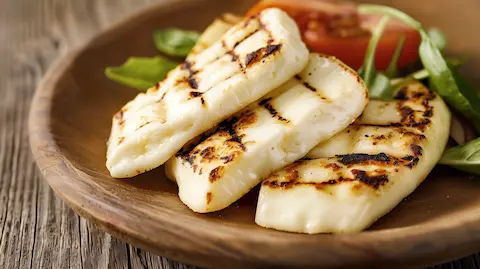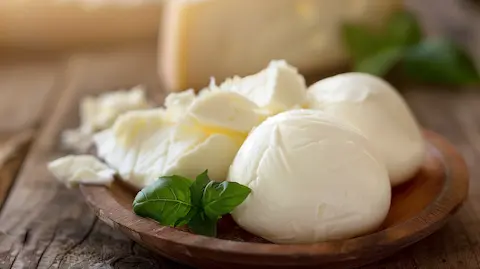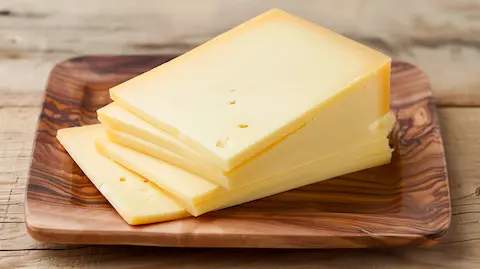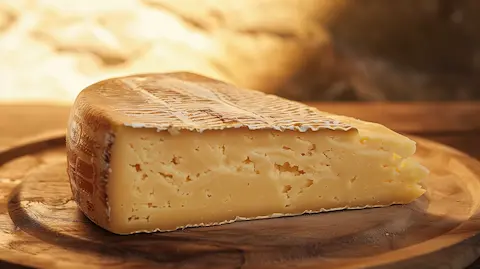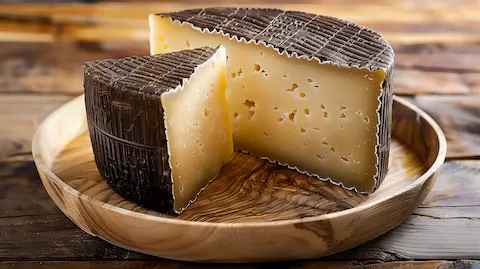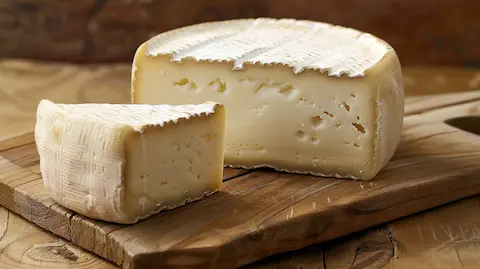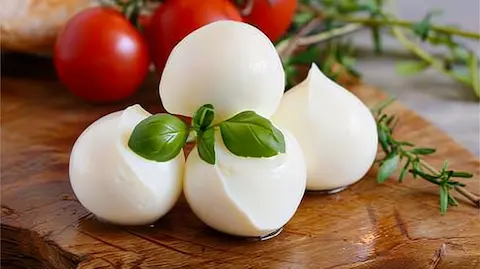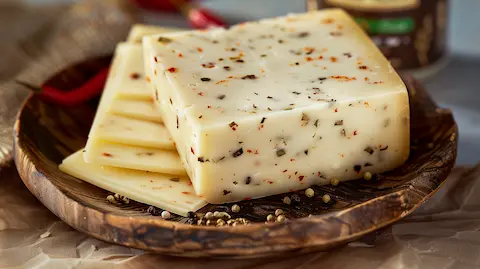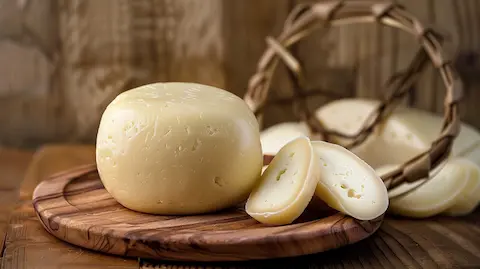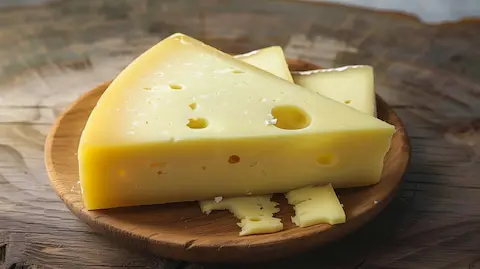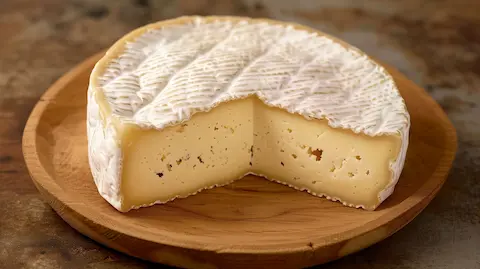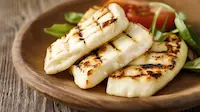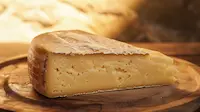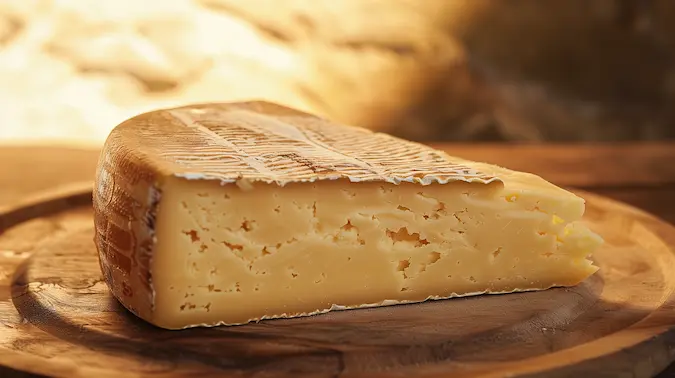What is Fontina cheese?
Fontina cheese is a semi-soft cow's milk cheese with a gentle buttery nut flavor and a smooth, creamy texture. Originating from Italy's Aosta Valley, Fontina has been a staple in Italian cuisine since the 12th century. Recognized by its orange-brown rind and rich, earthy taste, it melts beautifully, making it a favorite for fondue and gourmet cooking.
Understanding fontina cheese involves recognizing its versatility in the kitchen, its rich history, and the careful process by which it is made. These aspects contribute to Fontina's unique characteristics and its esteemed place in the world of cheese.
Let's now explore how Fontina cheese is crafted and what sets it apart from other cheeses.
How is Fontina cheese made?
Fontina cheese is made using traditional methods that have been refined over centuries. The process begins with high-quality cow's milk from the Aosta Valley, which is warmed and combined with rennet and bacteria cultures. Once the milk curdles, the curds are cut and gently heated, allowing whey to separate. These curds are then pressed into molds and brined to enhance flavor and preservation. The cheese is aged in cool, humid conditions, developing the characteristic rind and flavor profile unique to Fontina.
Here is an insightful table that outlines the production process of Fontina cheese:
Fontina Cheese Production Process
| Step | Ingredient/Method | Details |
|---|---|---|
| 1. Milk Preparation | Cow's milk | Milk from Aosta Valley cows, warmed to the right temperature. |
| 2. Curdling | Rennet, bacteria cultures | Addition of rennet and cultures to milk, curdling occurs. |
| 3. Curd Treatment | Heat | Curds are cut and heated to separate whey. |
| 4. Molding | Cheese molds | Curds are placed into molds to form the cheese shape. |
| 5. Brining | Saltwater brine | Cheese is soaked in brine to add flavor and aid preservation. |
| 6. Aging | Temperature and humidity control | Cheese is aged in specific conditions to develop flavor and rind. |
Fontina cheese profile
Exploring the profile of Fontina cheese reveals a tapestry of characteristics that define its identity in the culinary world. Each attribute contributes to the overall experience of enjoying this esteemed cheese.
- Made from: Cow's milk
- Country of origin: Italy
- Region: Aosta Valley
- Family: Italian semi-soft cheeses
- Type: Semi-soft
- Texture: Smooth and creamy
- Rind: Washed, orange-brown
- Color: Pale yellow
- Flavor: Mildly nutty, with a hint of sweetness
- Aroma: Earthy
- Vegetarian: No, traditional Fontina uses animal rennet
- Producers: Various, including artisanal and larger-scale cheesemakers
- PDO status: Yes, "Fontina Val d'Aosta" has Protected Designation of Origin status
Origin: Where does Fontina cheese come from?
Fontina cheese comes from the Aosta Valley, a region nestled in the Italian Alps. This cheese has deep roots in the local culture and has been produced in this region since the 12th century. The alpine climate and rich pastures provide ideal conditions for dairy farming, which in turn gives Fontina its distinctive qualities. The cheese benefits from the Protected Designation of Origin status, ensuring that only cheese produced in this specific region can bear the name 'Fontina'.
How to store Fontina cheese?
Proper storage of Fontina cheese is vital for maintaining its quality and extending its shelf life. Cheese should be kept in the refrigerator, wrapped in parchment paper or wax paper to allow it to breathe, and then placed in a plastic bag or container to prevent it from drying out. For best results, store Fontina in the vegetable compartment of the refrigerator, where the temperature is consistent and slightly higher than the rest of the fridge.
- Step 1: Wrap - Encase Fontina cheese in parchment or wax paper.
- Step 2: Seal - Place the wrapped cheese in a plastic bag or airtight container.
- Step 3: Set Temperature - Store in the vegetable compartment of the refrigerator.
How long does Fontina cheese last?
When stored correctly, Fontina cheese can last for several weeks. In the refrigerator, an unopened piece of Fontina can stay fresh for up to three months, while an opened piece should be consumed within three to four weeks to enjoy its optimal flavor and texture.
| Storage Location | Unopened | Opened | Notes |
|---|---|---|---|
| Outside | Not recommended | Not recommended | Room temperature can lead to spoilage. |
| Fridge | Up to 3 months | 3-4 weeks | Keep in the vegetable compartment for best results. |
| Freezer | Not recommended | Not recommended | Texture and taste may be compromised. |
Is Fontina cheese pasteurized?
Traditional Fontina cheese is not pasteurized; it is made using raw milk according to the standards for Protected Designation of Origin (PDO) products. However, some modern versions may use pasteurized milk to comply with international food safety regulations.
Next, discover alternatives to Fontina cheese that can be used in various recipes.
Can you freeze Fontina cheese?
Yes, you can freeze Fontina cheese, but it's not recommended. Freezing can alter its texture, turning the normally creamy cheese crumbly and dry. If you must freeze Fontina, use it for cooked dishes upon thawing to mask any textural changes.
Alternatives to Fontina cheese
For those seeking substitutes for Fontina cheese, several options offer similar textures and flavors suitable for various dishes. Whether due to availability or dietary preferences, these alternatives provide versatility in cooking.
Fontina Cheese Substitutes
| Cheese | Texture | Flavor Profile | Meltability | Best Used In |
|---|---|---|---|---|
| Gruyère | Semi-soft to hard | Slightly sweet, nutty | Excellent | Fondue, baking, gratins |
| Gouda | Semi-soft to hard | Rich, caramel-like | Very good | Sandwiches, sauces |
| Mozzarella | Semi-soft | Mild, milky | Exceptional | Pizzas, casseroles |
| Provolone | Semi-soft | Mild to sharp | Very good | Sandwiches, pizza |
| Emmental | Semi-hard | Fruity, nutty | Good | Fondue, charcuterie boards |
Next, learn how to incorporate Fontina into your cooking with various recipes.
How to use Fontina cheese
Fontina cheese shines in culinary applications where its melting qualities and rich flavor can be fully appreciated. It is ideal for creating a velvety texture in sauces and soups, and its creamy nature makes it a perfect addition to risottos and polentas. When sliced, Fontina adds a luxurious melt to sandwiches and burgers.
- Grate over hot dishes for a smooth melt
- Layer in lasagnas and casseroles
- Slice for sandwiches and paninis
- Cube for cheese platters
- Melt into fondues and dips
To cut Fontina cheese, use a sharp knife and slice according to the intended use—thin for sandwiches, diced for salads, or shredded for melting.
How to serve Fontina cheese
Serve Fontina cheese at room temperature to enhance its buttery flavor and aroma. Pair with fruits like apples and pears, nuts, and a selection of cured meats for a balanced cheese board. Complement with light-bodied wines or fruity ales for a delightful tasting experience.
Explore the nutritional profile of Fontina cheese in the next section.
Recipes using Fontina cheese
Fontina cheese's superb meltability and rich flavor make it a star ingredient in many dishes. Its creamy texture ensures smoothness in every bite, enhancing the overall taste experience.
- Fontina Fondue: The cheese's smooth melt is ideal for a rich, communal dip.
- Chicken Fontina: When melted atop poultry, Fontina adds a luxurious creaminess.
- Fontina Mac and Cheese: Elevates this classic comfort dish with its buttery flavor.
- Fontina and Mushroom Pizza: Offers a velvety contrast to the earthy mushrooms.
- Stuffed Fontina Burgers: Creates a gooey center that oozes with each bite.
Next, we'll explore Fontina cheese's nutritional data and how it fits into a balanced diet.
Fontina cheese nutrition data
There are 392 calories in Fontina cheese per 100g. This cheese also offers a range of nutrients, including protein and calcium, making it a nutritious addition to a balanced diet.
| Nutrient | Amount per 100g | % Daily Value* |
|---|---|---|
| Calories | 392 | |
| Total Fat | 31g | 48% |
| Saturated Fat | 19.8g | 99% |
| Cholesterol | 116mg | 39% |
| Sodium | 800mg | 33% |
| Total Carbohydrates | 1.55g | <1% |
| Dietary Fiber | 0g | 0% |
| Sugars | 0.97g | |
| Protein | 25.6g | 51% |
| Calcium | 550mg | 55% |
| Iron | 0.65mg | 4% |
*Percent Daily Values are based on a 2000 calorie diet. Your daily values may be higher or lower depending on your calorie needs.
Explore WhatCheese insights for a deeper understanding of cheese culture and industry trends.
What's next? WhatCheese insights
As the founder of WhatCheese, I've had the privilege of witnessing the ever-evolving cheese industry firsthand. One of the most exciting developments is the growing number of vineyards that offer cheese tastings alongside their wines. For those passionate about Fontina, I recommend visiting renowned vineyards in the Aosta Valley, where you can indulge in this cheese's perfect wine pairings. For instance, Les Crêtes vineyard provides an exceptional tasting experience that complements the nutty and earthy notes of Fontina with their exquisite wines.
Additionally, there are several myths surrounding cheese consumption that I'd like to address. A common misconception is that cheese is universally high in lactose, but many aged cheeses, including Fontina, have low lactose levels, making them more digestible for those with sensitivities.
For those seeking to purchase Fontina, specialty cheese shops and high-end grocers often carry authentic varieties. I also encourage you to support local cheesemongers who can provide you with the finest selections and share their extensive knowledge.
Cheese events are another avenue to explore the rich world of Fontina and other cheeses. The annual "Fiera di Sant'Orso" in Aosta showcases traditional foods, including Fontina, and offers a fantastic opportunity to immerse yourself in local cheese culture.
Let's move on to the unanswered questions you may have about Fontina cheese.

